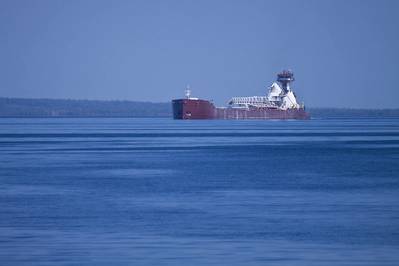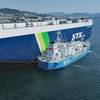The 2017 Great Lakes shipping season begins today when the U.S.-flag tug/barge unit Dorothy Ann/Pathfinder departs her winter lay-up berth in Erie, Pa., and sails to Cleveland, Ohio, where she will initiate the shuttle of iron ore from Cleveland Bulk Terminal to the ArcelorMittal steel mill at the end of the navigable portion of the Cuyahoga River on Wednesday. The vessel will load approximately 15,000 tons that was mined from Minnesota’s Mesabi Iron Range.
The next vessel to get underway will be the cement carrier Bradshaw McKee/St. Marys Conquest on March 1. The vessel will depart Charlevoix, Michigan, with 8,000 tons of cement for Milwaukee.
The western coal trade will resume on March 22 when the Paul R. Tregurtha loads 62,000 tons at Superior Midwest Energy Terminal in Superior, Wis., for delivery to the power plant in Silver Bay, Minn.
The locks at Sault Ste. Marie, Mich., that connects Lake Superior to the lower four Great Lakes, and the St. Lawrence Seaway reopen on March 25. According to the Lake Carriers’ Association (LCA), the Soo Locks typically handle more than 80 million tons of cargo in a season, about 80 percent of which transits the Poe Lock, the largest chamber at the Soo.
In 2016, U.S.-flag Great Lakes freighters moved 83.3 million tons of cargo, LCA said. Iron ore for steel production remained the fleet’s primary cargo, 44.1 million tons. Limestone loads for construction and steel production totaled 21.2 million tons. Coal cargos, most of which were for power generation, totaled 13 million tons. Other cargos included cement, salt, sand and grain.
Cargo totals in 2017 will be determined by the state of the economy, but a number of issues will determine the industry’s future. Regulation of ballast water is perhaps the most critical. Currently two federal agencies and 25 states regulate the discharge of ballast water, but legislation to end this patchwork approach has been introduced in the U.S. Senate. S. 168, The Commercial Vessel Incidental Discharge Act (CVIDA) consolidates the fractured system currently in place into a single, nationwide, federal ballast water discharge standard that employs the most stringent standard currently available.
Reliance on a single Poe-sized lock at The Soo continues to threaten the U.S. economy. More than 90 percent of the cargo U.S.-flag lakers move through the Soo Locks transits the Poe Lock. A 2016 U.S. Department of Homeland Security study forecasts that a six-month closure of the Poe Lock would bring steel production and heavy manufacturing to a virtual stop and leave nearly 11 million Americans standing in the unemployment line.
A second Poe-sized lock has been authorized at full federal expense, but a flawed analysis of the project’s benefit/cost (b/c) ratio by the U.S. Army Corps of Engineers (Corps) has stalled construction. The Corps has acknowledged the b/c ratio must be reexamined and a report is due by year’s end. A U.S. Department of Treasury report issued last month estimates a second Poe-sized lock could have a b/c ratio as high as 4.0, or nearly three times higher than the 0.73 estimated by the Corps.
Despite the mild winter of 2016/2017, the need for a second heavy icebreaker to bolster the U.S. Coast Guard’s aging fleet remains urgent. The cargos that were delayed or canceled by the massive ice formations during the winters of 2014 and 2015 cost the U.S. more than $1 billion in economic activity. The damage the ice caused during the 2013/2014 winter cost U.S.-flag vessel operators more than $6 million to repair. A number of vessels’ sailings were delayed in the spring of 2015 to avoid further damage.
A second heavy icebreaker was approved in the Coast Guard Authorization Act of 2015. Lake Carriers’ Association is now focusing its efforts on funding the $240 million icebreaker.
Although the last two Water Resources bills have increased funding for dredging Great Lakes ports and waterways, approximately 15 million cubic yards of sediment still need to be removed to allow for full loads. For example, if the Cuyahoga River was maintained to project dimensions, the Dorothy Ann/Pathfinder would have carried another 3,800 tons.











